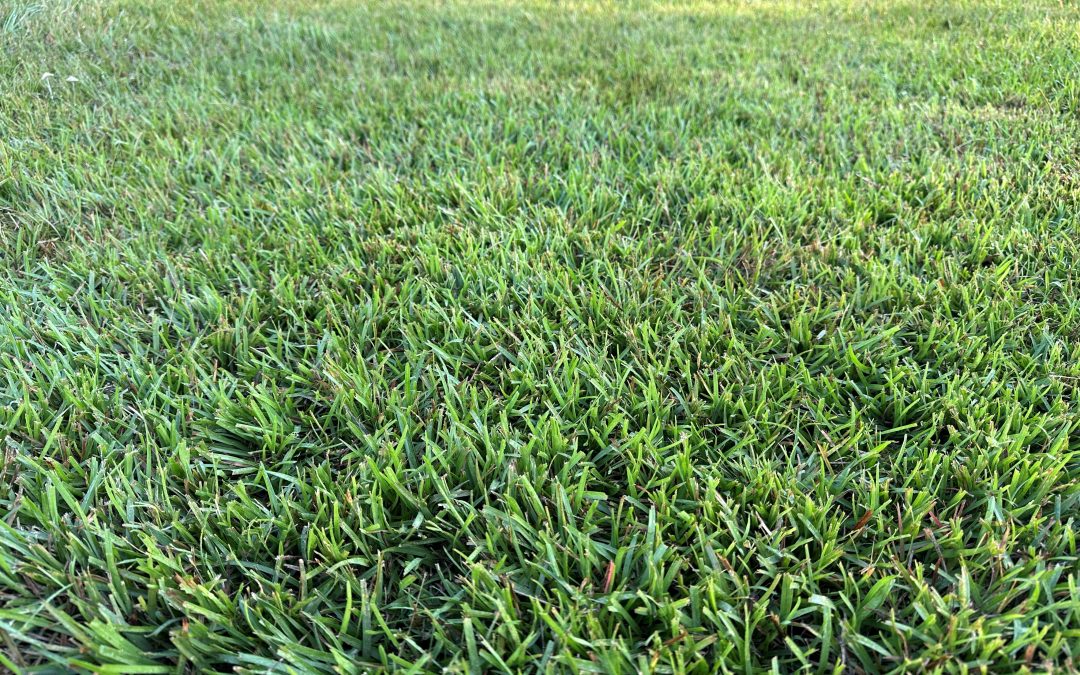
by Daniel J. Leonard | Oct 4, 2024
It’s hard to have a great yard full of Centipedegrass isn’t it? All the fertilizer, watering, aerating, weed spraying, fungicide spraying, insect spraying, the list is never-ending and wallet draining. Except, it’s not hard and doesn’t have to be expensive. It’s easy. In fact, it’s so easy that people even make it hard because they think it should be. The list of basic tips to achieve a great yard of Centipedegrass is very short, let’s get into it.
Fertilizing Properly – Keep it to a minimum! Centipedegrass has a very low Nitrogen (N) requirement for optimum growth and development (0.4 lbs – 2 lbs/1000 ft 2 per year). Centipede is naturally light green in color and trying to force the deep green of Kentucky Bluegrass upon it will almost certainly do it harm. There are many excellent quality Centipedegrass lawns in the Panhandle that have never received a single prill of fertilizer. Don’t take my word for it though, the UF/IFAS publication Centipedegrass for Florida Lawns says, “Established centipedegrass lawns require about 50% less nitrogen fertilizer than other lawn grasses grown in Florida. Centipedegrass is a low maintenance turfgrass and does not respond well to excessive use of fertilizer, especially nitrogen.”
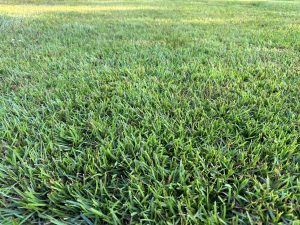
Centipedegrass lawn that has never been fertilized and mowed regularly when it reaches 3″ to achieve a 2.5″ cut height. Photo courtesy Daniel Leonard.
Timely Mowing – Other than overfertilizing, the next easiest way to cause significant damage to a Centipedegrass lawn is to mow it incorrectly. Centipede prefers a mowing height of around 2.5” and actively growing grass should be mowed every 7-14 days, removing no more than 1/3 of the grass blade. In my experience, this is much higher and often less frequent than many people mow their lawns. All too often, I see Centipede lawns that are allowed to grow tall and unkempt and then mowed to near golf course fairway height with the occasional bare “scalped” spot where the mower ran across an unlevel area of lawn. Mowing short and infrequently is harmful because mowing is inherently a major stress to the grass. You’re asking a lot of a plant by removing a large chunk of photosynthetic leaf tissue and then repeatedly asking the plant to regrow. Be kind to your grass and mow correctly. *Additionally, try to not mow your lawn in droughty conditions as this can exacerbate mowing stress and cause serious lawn issues.
Right Plant, Right Place – Much of the bad rap turfgrass receives comes from people trying to force it to grow where it shouldn’t be. If your yard has areas of significant shade or receives significant foot or vehicle traffic, Centipedegrass (or most any grass for that matter) may not be for you, in those areas at least. Like all turfgrasses (though some are more shade and traffic tolerant than others), Centipedegrass does best in full sun and detests having the soil its roots are going in repeatedly trampled and compacted. In areas with those conditions, maybe having a mulched landscaped bed with shade tolerant plants or a rocked walking path would be more appropriate. You and the grass will certainly be happier working with those options than fighting against your site conditions.
Though maintaining a Centipedegrass lawn is simple, that isn’t to say that if you follow all these tips that your yard will be perfect all the time. There will still be the occasional dieback, weed ingression, mole cricket infestation and the like, however, following the above tips will make your grass much more resilient and equipped to handle those stresses. For more information about Centipedegrass or other horticultural topics, contact your local UF/IFAS Extension office. Happy gardening!
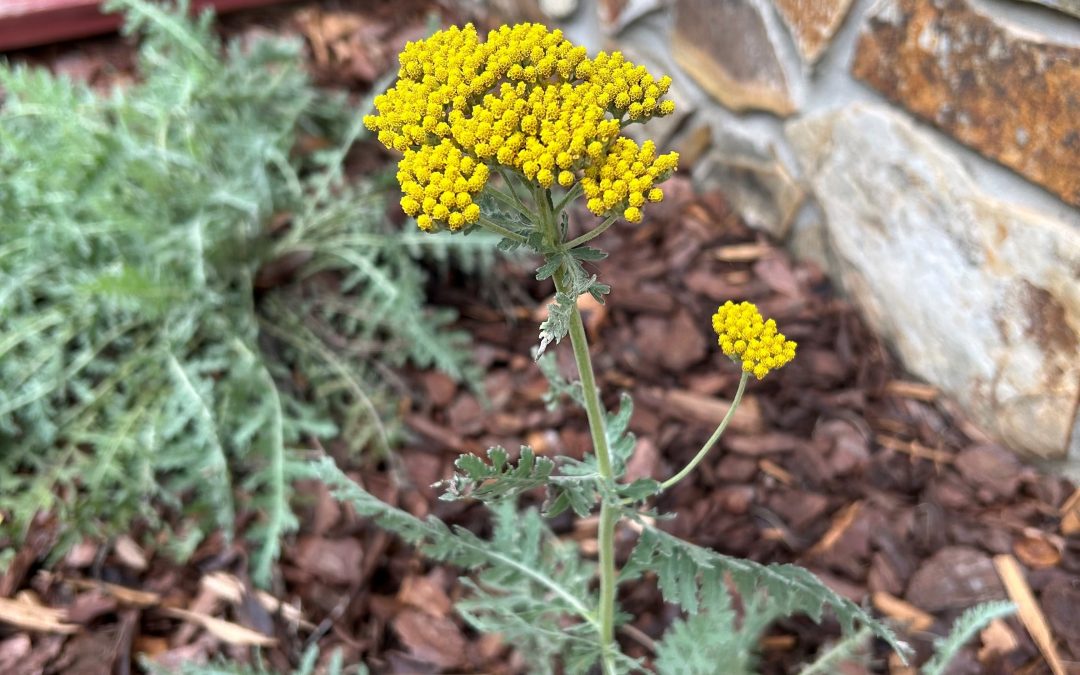
by Daniel J. Leonard | Sep 19, 2024
Problem areas in the landscape – everyone has them. Whether it’s the spot near a drain that stays wet or the back corner of a bed that sunshine never touches, these areas require specialized plants to avoid the constant frustration of installing unhealthy plants that slowly succumb and must be replaced. The problem area in my landscape was a long narrow bed, sited entirely under an eave with full sun exposure and framed by a concrete sidewalk and a south-facing wall. This bed stays hot, it stays dry, and is nigh as inhospitable to most plants as a desert. Enter a plant specialized to handle situations just like this – Yarrow ‘Moonshine’.
Yarrow (Achillea spp.) is a large genus of plants, occurring all over the globe. To illustrate, Common Yarrow (Achillea millefolium) is native to three different continents (North America, Europe, and Asia), making it one of the most widely distributed plants in the world. And though it was commonly grown and used in antiquity for medical purposes (the genus name Achillea is a reference to Achilles, who supposedly used the plant as a wound treatment for himself and his fellow Greek soldiers), I and most of you are probably more interested in how it looks and performs in the landscape.
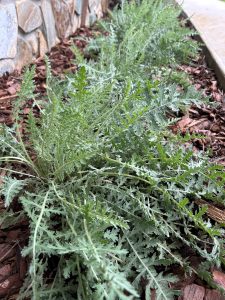
‘Moonshine’ Yarrow foliage.
All species of Yarrow share several ornamental traits. The most obvious are their showy flowers, which occur as large, flattened “corymbs” and come in shades of white, pink, red, and yellow. I selected the cultivar ‘Moonshine’ for my landscape as it has brilliant yellow flowers that popped against the brown wall of the house. Equally as pretty and unique is the foliage of Yarrow. Yarrow leaves are finely dissected, appearing fernlike, are strongly scented, and range in color from deep green to silver. Again, I chose ‘Moonshine’ for its silvery foliage, a trait that makes it even more drought resistant than green leaved varieties.

‘Moonshine’ Yarrow inflorescence.
If sited in the right place, most Yarrow species are easy to grow; simply site them in full sun (6+ hours a day) and very well drained soil. While all plants, Yarrow included, need regular water during the establishment phase, supplemental irrigation is not necessary and often leads to the decline and rot of Yarrow clumps, particularly the silver foliaged varieties like ‘Moonrise’ (these should be treated more like succulents and watered only sparingly). Once established, Yarrow plants will eventually grow to 2-3’ in height but can spread underground via rhizomes to form clumps. This spreading trait enables Yarrow to perform admirably as a groundcover in confined spaces like my sidewalk-bound bed.
If you have a dry, sunny problem spot in your landscape and don’t know what to do, installing a cultivar of Yarrow, like ‘Moonshine’, might be just the solution to turn a problem into a garden solution. This drought tolerant, deer tolerant, pollinator friendly species couldn’t be easier to grow and will reward you with summer color for years to come. Plant one today. For more information on Yarrow or any other horticultural question, contact your local UF/IFAS County Extension Office.
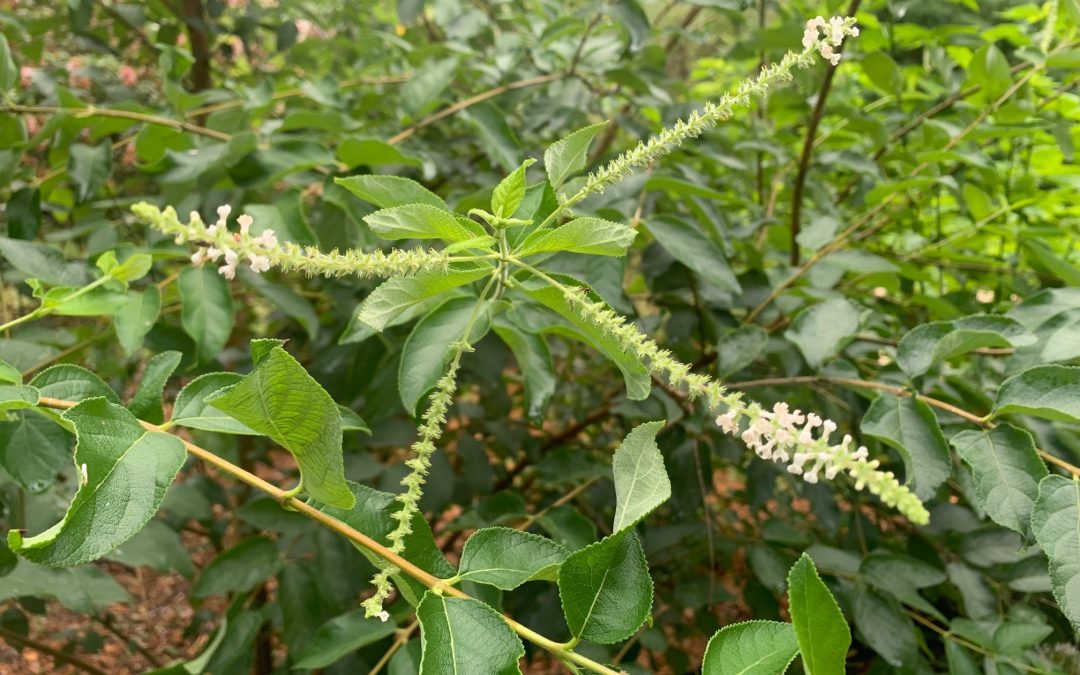
by Beth Bolles | Sep 4, 2024
Two years ago, the Escambia Master Gardener Volunteers were gifted with the flowering perennial Sweet Almond bush (Aloysia virgata). It has quickly become a favorite plant of volunteers and garden visitors due to its many attractive features.
Although, Sweet almond bush is not a Florida native, it is Florida-friendly plant for zones 8b -10b. Plants grow very large, from 6-10 feet with branching that can spread out in all directions. In North Florida, plants can be damaged by a freeze but either return from the base or from growing points higher on branches.
One of the best features are the fragrant white flowers spikes that will be present late spring through fall. Many types of pollinating insects will be attracted to the flowers, although sometimes flowers are too high on the plant for many of us to get a good look at pollinator details.
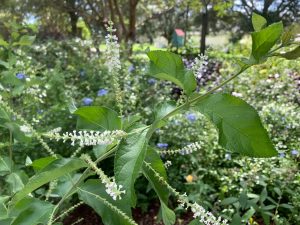
Sweet almond bush blooms. Photo by Beth Bolles, UF IFAS Extension Escambia County
We have plants both in full sun and partial shade that are performing well in the Escambia Demonstration Gardens. Plants do receive water when rainfall is lacking for about 5-7 days (or all of August this year in the Northwest Panhandle). You can shape your plant with a little light pruning during the growing season to keep branches a little more in bounds. Don’t forget to start a few new plants from these cuttings and then share a low maintenance plant with your neighbors.
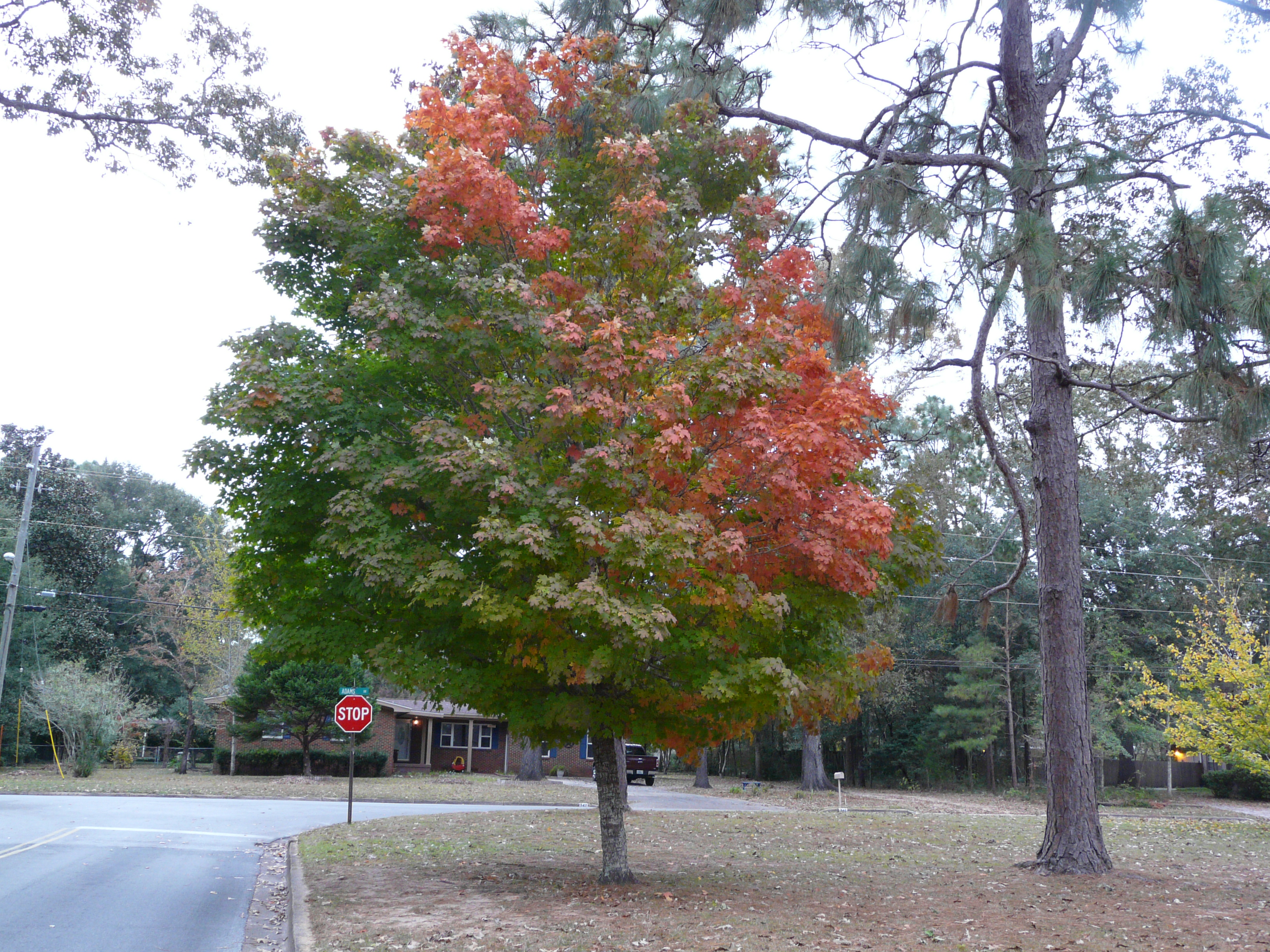
by Ray Bodrey | Sep 4, 2024
Fall is a season that is synonymous for two great joys in life…..football games and the changing leaf colors! However, in Florida we just don’t have the incredible burst of vivid fall leaf color as our northern neighbors enjoy each year, but we do have enough temperate region plants that can give us some seasonal change in foliage.
So what makes this brilliant display of autumn leaf color anyway? This seasonal change is brought on by a few variables, such as lower temperatures, shorter photo period/shorter days and chemical pigments found in leaf tissues. Some of the pigments that give autumn leaves their bright colors are actually present in the leaves as soon as they unfold as flush in early spring. But, during spring and summer, when the plants are growing vigorously, a green-colored material called chlorophyll dominates and shades out the other leaf pigments.
Chlorophyll plays on important role in a process called photosynthesis, which is the process by which plants capture energy from sunlight and manufacture food. Chlorophyll can also be found in water bodies and is an indicator of water quality. As plants get ready for cool season dormancy, the production on new chlorophyll decreases to almost being nonexistent. That’s when the before mentioned pigments, also called carotenoids, take over and make the leaves turn brilliant orange, red, purple and yellow.
There are some plants in the Florida’s landscape that do provide good fall color. Unlike most of the flowering shrubs, which hold their blossoms for only a brief period, the trees and shrubs that turn color in the fall will usually retain their varied hues for a month or more, depending on the weather.
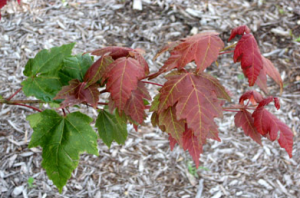
Red Maple. Credit. UF/IFAS Extension
What are some examples of trees that will lend fall color in your Panhandle landscape?
- Shumard Oak
- Turkey Oak
- Ginkgo
- Hickory
- Golden Rain Tree
- Red Swamp Myrtle
- Dogwood
- Red Maple (see photo)
- Sweet Gum
- Black Gum
- Crape Myrtle
- Tulip Tree
- Bradford Pear
- Cypress
What about annuals that provide color in the fall? Petunias, pansies and snapdragons will be in full bloom over the next few months.
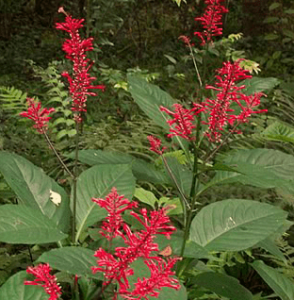
Firespike. Credit. UF/IFAS Extension
What about blooming perennials for fall? Salvia, firespike (see photo), chrysanthemum, beautyberry and holly are great for color in the fall and attract wildlife to your landscape.
A mix of these plants will ensure fall color in your landscape. For more information contact your local county extension office.
Information for this article was provided by Patrick Minogue, Forestry Specialist with UF/IFAS North Florida Research and Education Center, as well as the UF/IFAS Gardening Solutions: https://gardeningsolutions.ifas.ufl.edu/design/outdoor-living/gardening-for-fall-color/
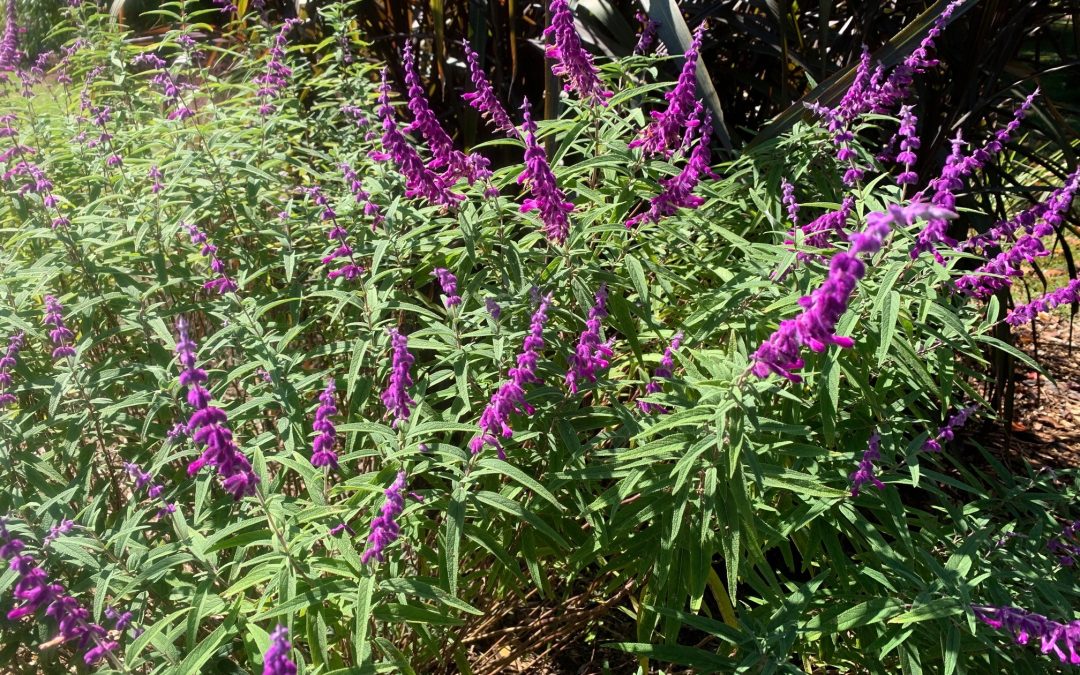
by Beth Bolles | Aug 20, 2024
Salvias are a popular group of plants for attracting pollinators and adding lots of color to the landscape. A unique salvia that offers velvety flowers is the Mexican bush sage, Salvia leucantha.
In our heat, Mexican bush sage can tolerate partial shade and likes average water with well drained soils. Plants will not overtake a spot only growing 2-4 feet. The velvety portion of the flower is a purple calyx with the flower petals emerging white or purple. Flower stalks will extend above the foliage to be available to many bees, butterflies, and hummingbirds.
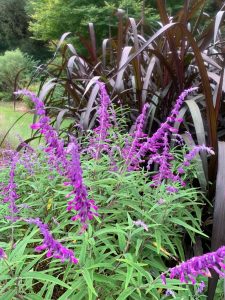
Mexican bush sage planted with ‘First Knight’ pennisetum. Photo by Bolles, UF IFAS Extension Escambia County.
During cold winters, plants can die back to the ground but often return each spring. It is always good to take a few cuttings for new plant starts just in case your plant dies back from heavy rains or drought conditions.
Mexican bush sage can be an accent plant in your garden or used in a small mass of 2-3 plants. Consider adding it with contrasting textures and colors so later summer flowers are easily visible.
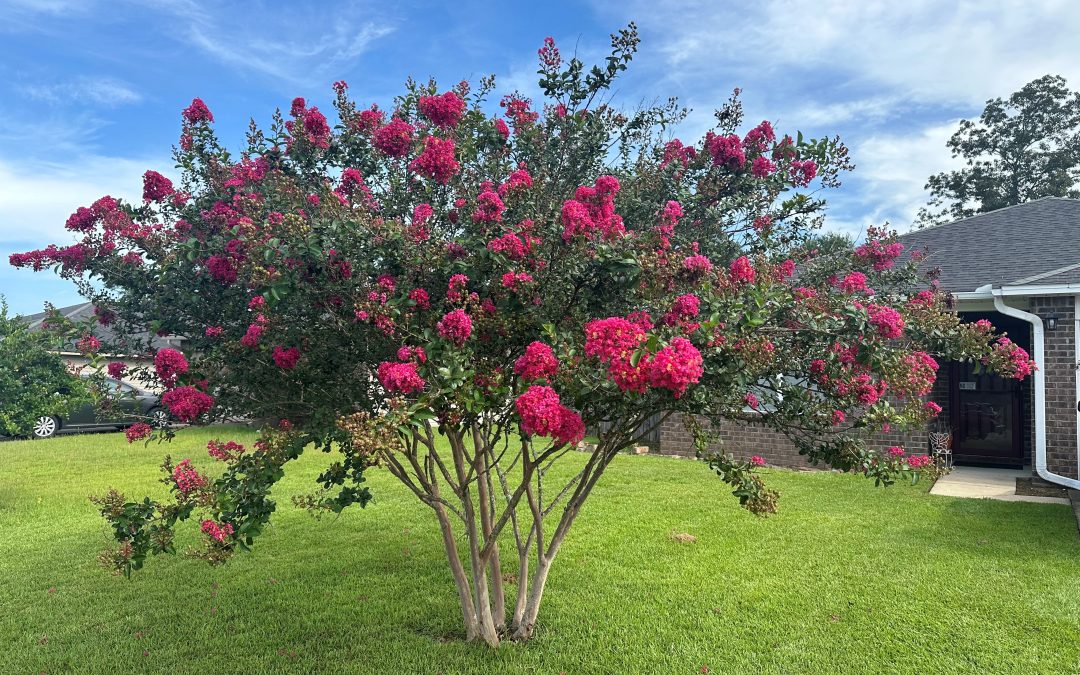
by Daniel J. Leonard | Aug 12, 2024
Despite being a near-perfect ornamental for the Panhandle, Crape Myrtle is often misused. Though there are dozens of commercially available varieties in all shapes and sizes, many people choose the wrong one for their yard. The most commonly sold cultivars ‘Natchez’ (white flowers), ‘Muskogee’ (pink flowers), and ‘Tuscarora’ (watermelon red flowers) – all three attain mature heights more than 20’ – are almost always too large for siting near a house or other structure and are often out of scale with landscapes. The simple solution to making the best use of Crape Myrtle in smaller yards (certainly not dramatic pruning – Crape Murder is among the worst landscape sins), is to select a smaller growing variety and ‘Tonto’ is a personal favorite in this category.
‘Tonto’ Crape Myrtle, one of the selections that emerged from Dr. Don Egolf’s Crape Myrtle breeding program at the U.S. National Arboretum over 50 years ago, is among my favorite Crape Myrtle varieties for several reasons. First, Tonto’s fuchsia hued flowers are as vibrant as flowers come; they practically glow in the landscape. The flower show lasts for several months and are a valuable food source for pollinators, bees in particular, in the late summer when few things are blooming. Tonto also is a relatively slow grower that only reaches about 10’ tall and wide at maturity. This allows the variety to be exceedingly versatile in landscapes as it can be used in the background of planting beds, as a specimen plant, limbed up as a small tree in open areas, or even placed in very large containers. Finally, beyond just the flower show and ideal size, ‘Tonto’ has uniquely attractive, cream colored, exfoliating bark and reliably attractive fall foliage. Both these features add interest to landscapes, even when ‘Tonto’ isn’t flowering.
Though ‘Tonto’ sports many unique qualities, it shares many other excellent traits and growing preferences with its Crape Myrtle kin. For best results growing any Crape Myrtle, trees should always be sited in full sun, at least 6-8 hours a day. Shading will result in greatly reduced flowering and lanky plants. Regular watering during the first year after planning while trees are becoming established is helpful, as is periodic fertilizer application. Once established, ‘Tonto’ and all other Crape Myrtles are exceedingly drought tolerant and can get by on their own with minimal inputs from gardeners.
If you’ve been struggling with a Crape Myrtle that has outgrown its site or thinking about planting a new Crape, I’d encourage you to give ‘Tonto’ a look. It’s an outstanding shrub/small tree, will reward you with flaming fuchsia flowers and smooth cream-colored bark each summer, and will never outgrow its space. Plant one today! For more information on growing Crape Myrtles or any other horticultural topic, contact us at the UF/IFAS Calhoun County Extension Office. Happy gardening.













